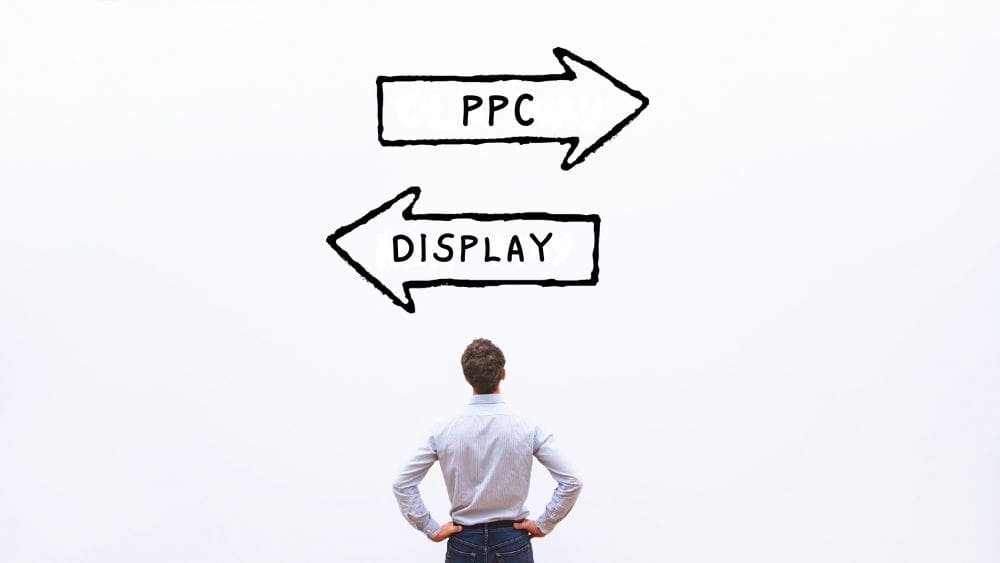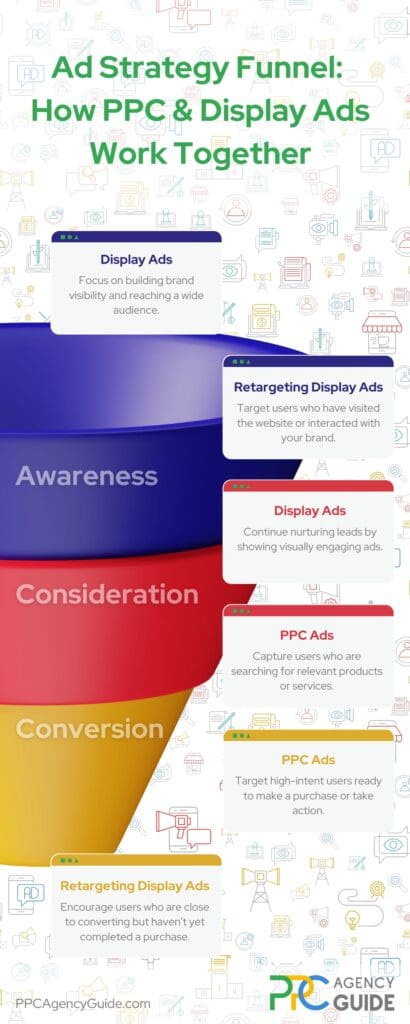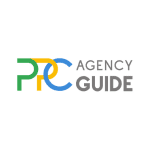
Struggling to decide whether pay-per-click (PPC) vs. display advertising is right for your business? You’re not alone. They have so much in common it can be difficult to tell them apart. However, there are key differences, and understanding them can help you unlock the full potential of digital advertising for your business.
PPC and Display Ads Comparison: Simplified Explanation
If you’re hoping to understand the differences between PPC vs. display advertising quickly, it can be summed up as this:
- PPC refers to a payment model used in online advertising. It means your brand pays each time someone clicks on one of your ads. These ads can be in search engines, websites, apps, and more.
- Display advertising is a type of online advertisement that uses visuals, such as graphics and videos, to capture your audience’s attention. Display ads can be on websites, in apps, and more.
- Display ads can use the PPC model, meaning some display ads are PPC ads. However, not all PPC ads are display ads.
With that said, there are additional nuances to how each works and times when you might want to choose one type over the other. We’ll explore both in greater detail below and provide an enhanced comparison at the end.
PPC: A Deeper Look
As mentioned, PPC is an online advertising model where businesses pay a fee each time their ads are clicked. It’s essentially a way of buying website visits rather than organically earning them. The most common platform for PPC is Google Ads, though you can also run PPC campaigns on Microsoft Advertising, Facebook, and other social media channels.
How PPC Works
Let’s start with a simplified breakdown of the typical PPC process.
Ad Placement
Advertisers create ads and bid on keywords relevant to their business or offering. For instance, if you own a bakery, you might bid on terms like “best cupcakes near me.” These ads appear in prominent places on search engine results pages (SERPs) or websites.
Auction System
When someone searches for the keywords you’ve bid on, an auction is triggered behind the scenes. The search engine evaluates all ads bidding on those keywords based on factors like bid amount and ad relevance (not just who’s paying the most) to decide which ad gets shown.
Cost
You only pay when someone clicks on your ad. For example, if you’re running a campaign with a $2 bid per click and 100 people click on your ad, you’d pay $200. Your bid, ad quality, and competition determine the actual cost-per-click (CPC).
Advantages of PPC Advertising
Now that you know how it works, let’s explore a few PPC benefits.
- Immediate Visibility: PPC ads can appear at the top of search results or on high-traffic websites almost instantly, giving your business immediate exposure.
- Targeted Reach: PPC allows you to target specific audiences based on keywords, demographics, locations, and even behaviors, ensuring your ads are seen by relevant prospects.
- Cost Control: You set your budget and only pay when someone clicks on your ad, making PPC a cost-effective way to control ad spending and optimize ROI.
- Measurable Results: PPC platforms offer detailed analytics, allowing you to track clicks, impressions, conversions, and other metrics in real-time, helping you refine your strategy.
- Flexibility: Campaigns can be easily adjusted to respond to performance data, market changes, or business needs, giving you control to pivot quickly.
- Increased Brand Awareness: Even if users don’t click on your ads, frequent visibility in search results or display networks builds brand recognition over time.
- High Conversion Potential: PPC often drives higher conversion rates than other advertising methods because it can target high-intent users (such as those searching for specific products or services).
- Retargeting Opportunities: You can retarget users who have already visited your site, increasing the chance of conversion by staying top-of-mind for prospects.
Types of PPC
Because PPC refers to a payment model, many types of digital ads can be PPC ads. A few examples include:
- Search Advertising: With search advertising, ads appear in search engine results when users search for specific keywords. This is ideal for capturing high-intent traffic.
- Shopping Ads: Great for e-commerce, shopping ads are product-based ads with images and prices displayed on search results.
- Social Media Advertising: When you place targeted ads on platforms like Facebook or LinkedIn, focusing on user demographics and interests, it’s referred to as social media advertising.
- Retargeting: You’ll use retargeting ads to reach users who previously visited your site and encourage them to return and complete an action.
- Video Advertising: Placing video ads on platforms like YouTube is effective for storytelling and engaging audiences.
- Native Advertising: Ads that match the look and feel of the platform they appear on, blending with the content, are called native advertising.
- App Advertising: To promote a mobile app across platforms and drive downloads and engagement, you’ll use mobile app ads.
- Display Advertising: Visual banner ads shown across websites to build brand awareness are referred to as display ads.
Display Advertising: A Deeper Look
Display advertising is a type of online advertising in which businesses place visual ads, such as banners, images, or videos, on websites within a display network. The Google Display Network is a prime example. It allows you to reach over 90 percent of worldwide internet users, the company reports.
Display ads are ideal for brand awareness, remarketing, and engaging users who may not be actively searching for your product or service. For a closer look at how major platforms stack up, check out our full display ad networks comparison, which outlines differences in targeting capabilities, pricing models, and audience reach across top networks
How Display Advertising Works
Although each advertising network operates a bit differently, setting up display ads typically involves the same core steps, as outlined below.
Ad Creation
Businesses create visually engaging ads that promote products, services, or brand awareness. These ads can be static images, animated graphics, or even videos.
Ad Placement
Display ads are shown on websites, apps, or social media platforms that are part of a display network. You can target specific websites or use automatic placements based on audience preferences.
Targeting
Display ads can be highly targeted based on user demographics, interests, browsing history, or behaviors. For example, someone who recently searched for travel destinations might see ads for hotels or vacation packages.
Payment Model
Similar to PPC, advertisers can pay based on impressions (CPM, or Cost Per Thousand Impressions) or clicks (CPC, or Cost Per Click).
Advantages of Display Advertising
There are many benefits to display ads for businesses. We’ll review a few below.
- Wide Reach: Display ads can reach a vast audience across millions of websites, apps, and social media platforms, helping you connect with potential customers at scale.
- Brand Awareness: With visually engaging formats, display ads are excellent for increasing brand visibility and recognition, even if users don’t click right away.
- Precise Targeting: Display advertising allows for advanced targeting, including demographics, interests, behavior, and retargeting, ensuring your ads reach the most relevant audiences.
- Retargeting: Display ads are beneficial for retargeting, allowing you to show ads to users who have previously visited your site, keeping your brand top-of-mind and encouraging them to return.
- Engaging Ad Formats: Unlike text-based PPC ads, display ads can include images, animations, and videos, making them more engaging and effective for grabbing attention.
- Cost-Effective: Display ads often have a lower CPC than search ads, allowing businesses to build awareness without a large ad spend.
- Cross-Device Reach: Display ads can be shown on various devices, from desktops to smartphones, ensuring consistent brand exposure across different platforms.
- Supports Visual Branding: For businesses that rely on strong visual branding, such as fashion or home décor, display ads provide the creative space to make a visual impact.
PPC vs. Display Advertising: Understanding the Differences
Now that we’ve covered them independently, let’s take a deeper look at PPC vs. display marketing in comparison.

PPC vs. Display Advertising Cost
When comparing PPC and display advertising costs, there are some notable differences, primarily driven by the ad format, audience intent, and competitive nature of each platform.
PPC Costs
PPC encompasses various ad types—search, social media, shopping, and video ads—and the costs can vary significantly across these platforms.
- CPC: The CPC for PPC ads is typically higher than display ads, especially for search and shopping ads, where the audience has strong purchase intent. Average CPCs can range from $1 to $10 or more, depending on the platform and industry.
- Social: On social media PPC (Facebook, Instagram, LinkedIn), the CPC tends to be lower, averaging between $0.50 to $3, though it varies based on the target audience and competition.
- Video: The cost per view for video ads on platforms like YouTube can range from $0.10 to $0.30, making video PPC an affordable option for driving engagement.
- Flexible Budgeting: PPC ads across all platforms—whether it’s Google Search, Facebook Ads, or YouTube—allow you to control costs by setting daily or total campaign budgets. You only pay when someone clicks on or engages with your ad, making it highly cost-effective and measurable.
- Targeted Reach: PPC costs are often justified by the precision of targeting. Ads are delivered to users who have shown interest through searches, demographic settings, or browsing behaviors, which leads to higher conversion rates despite the higher cost-per-click.
Display Advertising Costs
Display ads, whether part of a display network (like the Google Display Network) or on social platforms, tend to have lower overall costs because they target users passively browsing the web rather than those actively searching or engaged.
- Cost Per Thousand Impressions (CPM): CPM for display ads is often lower, typically between $1 to $5 per thousand impressions, depending on the targeting and placement. Display ads tend to reach larger audiences but may not immediately convert viewers into customers. The focus is more on brand awareness and visibility rather than direct action.
- Lower CPC: When using the CPC model for display ads, costs can range from $0.30 to $1.50 per click, which is significantly lower than search and shopping PPC ads. However, the lower CPC comes with lower intent, as display ad viewers are often in the awareness or interest stage.
- Wide Reach at a Lower Cost: Display advertising can reach a large number of people across different websites and apps at a much lower cost than PPC ads. This makes it an excellent option for businesses looking to build brand awareness rather than immediate conversions.
PPC vs. Display Advertising Cost Summary
- PPC Ads (across search, social media, shopping, and video): These generally have higher CPCs due to strong targeting and audience intent but offer excellent conversion potential. Average costs depend on the platform and can range from $0.50 to $10 or more per click.
- Display Ads: Lower CPM and CPC, typically used for brand awareness and retargeting. You can expect a CPM between $1 to $5 and CPCs under $1.50, with a focus on broad, passive audiences rather than high-intent users.
PPC vs. Display Advertising Effectiveness
Next, let’s break down the effectiveness of PPC vs. Display Advertising, focusing on their goals, audience engagement, and the stages of the customer journey they best serve.
PPC Effectiveness
- High-Intent Targeting: PPC ads, such as search, shopping, and social media ads, are most effective when targeting users who are actively searching for or showing interest in a product or service. These users tend to be further along in the buying process, making PPC ideal for driving conversions. For example, someone searching for “emergency plumbing service” is likely ready to hire, so a well-placed PPC ad can immediately lead to a sale.
- Better for Immediate Results: PPC campaigns, particularly search ads, can deliver immediate traffic and conversions as they appear to users actively seeking solutions. This makes PPC highly effective for businesses looking for quick returns on investment (ROI).
- Precise Targeting Options: Across platforms like Google Ads or Facebook Ads, PPC allows advertisers to target users based on their search intent, behaviors, demographics, location, and even interests. This ensures that your ad reaches the right people at the right time, maximizing the effectiveness of your budget.
- Higher Conversion Rates: Because PPC reaches users with high intent, it often has a higher conversion rate than display ads. The average conversion rate for search ads is about 3.75 percent, according to WordStream. This is higher than most forms of digital advertising. For shopping ads, the conversion rate can be even higher.
Display Advertising Effectiveness
- Brand Awareness: Display ads are less about driving immediate conversions and more about increasing visibility and brand recognition. They’re effective at keeping your business top-of-mind by passively reaching users as they browse the web. For companies focused on building awareness, display advertising is highly effective at introducing new users to the brand.
- Effective for Retargeting: Display ads shine in retargeting campaigns—serving ads to users who have already visited your website but haven’t converted. By showing ads on other websites or apps, you can nudge potential customers back to your site to complete their purchase. Retargeting campaigns can increase conversion rates by 70 percent or more, according to Business.com.
- Wider Audience Reach: Unlike search ads, display ads can reach a broader, more diverse audience by appearing on various websites within the display network. This makes them an effective tool for broadening your reach and attracting users who may not have been actively searching for your product but could still be interested.
- Lower Click-Through Rates (CTR): Since display ads target passive users who aren’t actively searching for your product, they typically have a lower CTR than PPC search ads. The average CTR for display ads is around 0.35 percent compared to 1.91 percent for search ads, according to WordStream.
Which is More Effective: PPC vs. Display Ads
It depends on your goals:
- For Conversions and ROI: PPC (across search, social media, and shopping) is more effective at driving direct conversions because it targets users with high intent.
- For Brand Awareness: Display advertising is more effective for reaching a large audience, building brand visibility, and staying top-of-mind, especially for retargeting campaigns.
- For Retargeting: Display ads can be incredibly effective when used for retargeting, reminding users of products they’ve shown interest in.
In short, PPC is more effective for driving immediate action, while display ads are best for nurturing interest and building brand awareness over time. Many businesses use both strategies in tandem—PPC for conversions and display for awareness and retargeting—to achieve the best results.
PPC vs. Display Advertising ROI
When comparing PPC vs. display advertising in terms of ROI, the effectiveness of each depends largely on the business goals, the nature of the campaign, and the audience targeting. Let’s break it down.
PPC ROI
- Higher ROI for Direct Conversions: PPC campaigns, particularly search ads, tend to deliver a higher return on investment because they target users with high purchase intent. For example, someone searching for “buy running shoes online” is likely ready to make a purchase, so a well-placed PPC ad can result in an immediate sale. The conversion rates for PPC search ads average around 3.75 percent, leading to solid ROI, especially in competitive markets.
- Clear and Measurable: One of the critical advantages of PPC is the ability to precisely track your return on investment. To assess whether your campaign is profitable, you can measure the cost per click (CPC), cost per acquisition (CPA), and total conversions. Businesses make an average of $2 for every $1 spent on Google Ads, the platform reports.
- Immediate Results: PPC offers quick results, making it ideal for businesses seeking fast conversions or promotions that need an immediate boost. The direct targeting of keywords and audience behaviors ensures that your ad reaches users who are more likely to convert, resulting in a faster and often higher ROI.
- Scalable ROI: PPC campaigns are easily scalable. You can increase your ad spend on high-performing campaigns to drive even more conversions while maintaining a solid ROI. Many businesses that optimize their PPC campaigns find that the returns grow as they increase investment.
Display Advertising ROI
- Longer-Term ROI: Display ads are more focused on building brand awareness, so the ROI may take longer to materialize than PPC ads. Users often see these ads passively browsing, meaning they are less likely to convert immediately. However, over time, display ads help create brand recognition, which can lead to increased conversions in the future.
- Lower CPC, but Lower Conversion Rates: Display ads usually have a lower cost per click (CPC) than PPC ads, making them cost-effective for reaching a large audience. However, the lower conversion rates (average CTR of 0.35 percent) mean the immediate ROI is often lower. That said, they can still deliver strong returns when used for retargeting or to support broader marketing goals like brand recall.
- Effective for Retargeting: When used for retargeting, display ads can deliver excellent ROI by bringing back users who have already shown interest in your product. Retargeting campaigns often result in higher conversion rates because they target warm leads who are already familiar with your brand. As mentioned, retargeting display ads can improve conversion rates by as much as 70 percent.
- Brand Awareness Value: While the ROI from display advertising might not always show up in direct conversions, it has a hidden ROI through brand awareness and recall. Over time, repeated exposure to your display ads can make your brand more recognizable and trustworthy, leading to higher engagement and future conversions.
Which Delivers Higher ROI: PPC vs. Display Advertising
- PPC Ads: Generally deliver higher ROI in the short term because they target users with high intent. Businesses looking for quick returns or immediate sales often find that PPC ads outperform display ads in terms of direct revenue generation.
- Display Ads: Provide strong ROI over the long term, particularly for brand-building and retargeting. While they may not lead to immediate conversions, their ability to nurture leads and build awareness can lead to future sales and customer loyalty, which translates into long-term ROI.
If your goal is immediate sales and measurable ROI, PPC ads (particularly search and shopping) will likely provide the best return on investment. However, if your focus is on building brand recognition and nurturing leads for future conversions, display ads can offer a strong, albeit longer-term, ROI. Many businesses find success by using both—PPC for quick wins and display for sustained brand growth.
PPC vs. Display for Small Businesses
For small businesses, the choice between PPC and Display Advertising depends on their goals, budget, and how quickly they need to see results. Both strategies have unique advantages, and small businesses can benefit from using one or both, depending on their needs. Let’s break it down.
When to Use PPC
- Immediate Results and Conversions: PPC is ideal for small businesses that need fast results, such as driving immediate sales or generating leads. Since PPC ads (especially search ads) target users with high intent—people actively searching for products or services—small businesses can start seeing conversions immediately. This makes PPC especially useful for promotions, launching new products, or filling up appointment slots.
- Cost Control: PPC allows small businesses to control their budget tightly. You only pay when someone clicks on your ad, and you can set daily or campaign-wide limits. This makes it easier to manage advertising costs while focusing on high-performing keywords and targeting options that lead to better returns.
- Localized Targeting: Small businesses often rely on local customers, and PPC is perfect for this. Platforms like Google Ads allow for geo-targeting, so companies can show ads only to people within a specific geographic radius. For instance, a local bakery can target users searching for “best cupcakes near me” within a 10-mile radius of their shop.
- Quick Adjustments and Flexibility: With PPC, small businesses can quickly tweak their campaigns based on real-time performance. Whether it’s adjusting bids, changing ad copy, or refining keyword targeting, PPC offers flexibility to improve performance on the fly.
When to Use Display Advertising
- Cost-Effective Brand Awareness: Display ads are typically cheaper than PPC ads in terms of CPC or CPM. This makes them an excellent option for small businesses that want to build brand awareness without spending a large budget. Display ads are less focused on direct conversions and more about creating visibility for the brand, which can be critical for small businesses in competitive markets.
- Visual Impact: Display ads allow small businesses to showcase their products or services in a visually engaging format. For companies with eye-catching products—such as boutiques, restaurants, or home décor shops—display ads offer a great way to connect emotionally with potential customers. A small home goods store could use image-heavy ads to attract attention on lifestyle blogs or relevant websites.
- Retargeting: Retargeting via display ads is highly effective for small businesses. These ads can follow users who have previously visited their website or engaged with their content, reminding them of products they’ve shown interest in. For example, a local gym could use display retargeting to bring back users who viewed their membership pricing but didn’t sign up, improving conversion potential.
- Longer-Term Growth: Display ads might not drive immediate sales, but they help small businesses with long-term brand recognition. Display ads can create multiple touchpoints with potential customers, so when they are ready to make a purchase, the business’s brand is already familiar.
Which is Better for Small Businesses: PPC vs. Display Advertising
- PPC Ads: Best for small businesses that need immediate results, such as increasing sales or generating leads quickly. It works particularly well for local services, e-commerce, and companies with clear search intent from their customers. The ability to target specific keywords and audiences means small businesses can make the most of limited budgets by focusing on high-converting traffic.
- Display Ads: Ideal for small businesses looking to build brand awareness and nurture potential customers over time. Display ads are cost-effective for getting your business in front of a large audience and can be used to keep your brand top-of-mind through retargeting. It’s an excellent option for companies that need more visual impact and want to create lasting impressions without focusing entirely on immediate conversions.
Get Expertly Crafted PPC and Display Advertising Campaigns
Simply knowing the difference between PPC and display ads isn’t enough. You must be able to draw on the right tools for your business’s needs and goals and craft compelling campaigns on top of it. This usually requires having an entire team of specialists who understand the nuances of strategy, copywriting, design, and more, which isn’t realistic for most small and mid-sized businesses. That’s where finding an experienced PPC agency comes in. We’ll match you with a talented firm that already has talent in place and can develop a winning strategy based on your goals, whether that’s PPC, display, or a fusion of both. To get started, request a complimentary consultation.

PPC vs. Display Advertising FAQs
Which is more effective: PPC or display advertising?
PPC is generally more effective for driving conversions and immediate results since it targets users actively searching for products or services. Display ads are better for building long-term brand awareness and retargeting but may not drive instant conversions.
How does PPC advertising work for small businesses?
PPC helps small businesses quickly generate leads and sales by targeting users who are searching for specific products or services. It’s cost-effective because companies only pay when someone clicks the ad, and they can control spending with flexible budgeting.
What are the benefits of using display ads vs. PPC?
Display ads are great for reaching a broad audience and building brand recognition. They offer lower costs per impression and work well for retargeting campaigns. PPC is better for targeted campaigns with high intent and faster conversions.
How much does PPC advertising cost compared to display advertising?
PPC typically has a higher cost-per-click (CPC) due to its intent-driven targeting, ranging from $1 to $10 or more, depending on the industry. Display ads have lower CPCs or CPMs, often under $1, making them more cost-effective for brand awareness.
When should I use display ads instead of PPC?
Use display ads when your goal is to build brand awareness, create visual impact, or retarget users who have visited your website. They’re also useful for reaching a broad audience at a lower cost than PPC.
Can PPC and display ads be used together in a marketing strategy?
Yes, combining PPC and display ads can be highly effective. PPC can drive immediate sales or leads, while display ads build awareness and retarget users who have previously interacted with your brand, creating a full-funnel approach.
What is the average ROI for PPC advertising?
PPC campaigns can offer a strong ROI, with many businesses making an average of $2 for every $1 spent on Google Ads. ROI varies by industry, keywords, and campaign optimization, but the precise targeting often leads to high conversion rates.
Are display ads effective for brand awareness?
Yes, display ads are excellent for building brand awareness. They reach a large audience, often at a lower cost than PPC, and can visually engage users as they browse the web, increasing brand visibility and recognition over time.
How do PPC and display ads fit into a small business marketing budget?
PPC can drive immediate sales with a defined budget, while display ads provide cost-effective brand awareness. Small businesses often use PPC for quick results and display ads for sustained brand growth, ensuring a balanced marketing approach.
What are some PPC advertising examples?
Examples of PPC advertising include Google Search Ads, Facebook Ads, and Instagram Ads, each targeting users based on interests and behaviors. For instance, optimize your mobile PPC campaigns on Instagram by creating highly engaging ads that resonate with users on their feed and maximize conversions with Instagram ads.. Other examples include Shopping Ads, LinkedIn Ads, and YouTube Ads, all offering different ways to reach and engage potential customers across various platforms.
What PPC targeting options are available?
PPC targeting options include keyword targeting, where ads show for specific search terms; demographic targeting based on age, gender, income, etc.; location targeting to reach users in specific geographic areas; device targeting (mobile vs. desktop); and behavioral targeting, which leverages users' online activity.
What display advertising targeting options are available?
Display advertising offers several targeting options, including contextual targeting (ads placed on relevant websites), demographic targeting, interest-based targeting, and retargeting, which targets users who previously visited your website. You can also use placement targeting to show ads on specific websites or apps, and affinity targeting to reach users with particular interests.


















